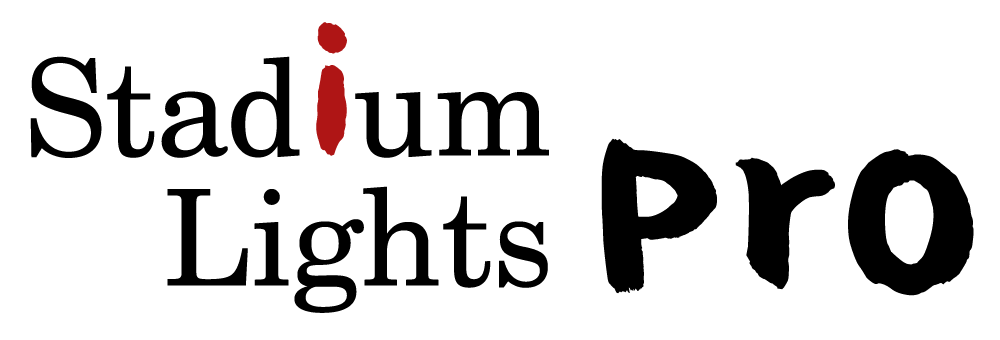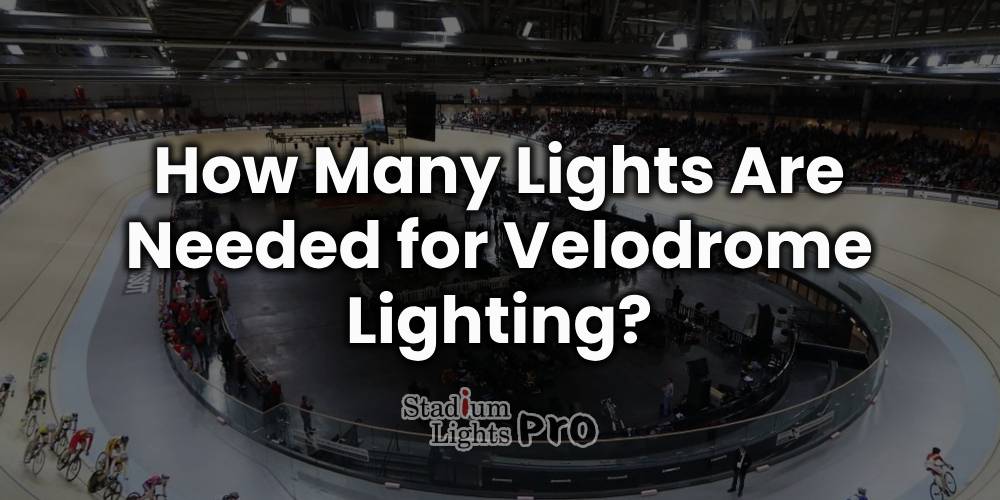Velodromes are specialized arenas designed for track cycling, featuring a banked oval track that challenges both speed and agility. The architecture of a velodrome typically includes a wooden or concrete track surrounded by seating and interior amenities. Lighting plays a fundamental role in supporting both athlete performance and audience experience. The height of the ceiling, curvature of the track, and spacing of seats are all variables that influence lighting decisions.
Before calculating how many lights are required, it is helpful to understand the shape and surface of the track. A velodrome may be indoors or outdoors, and indoor tracks usually range from 150 to 250 meters in length. Uniform illumination is vital for safety and visibility, ensuring that every section of the track remains visible regardless of motion or position.
Table of Contents
ToggleLighting Objectives in a Velodrome
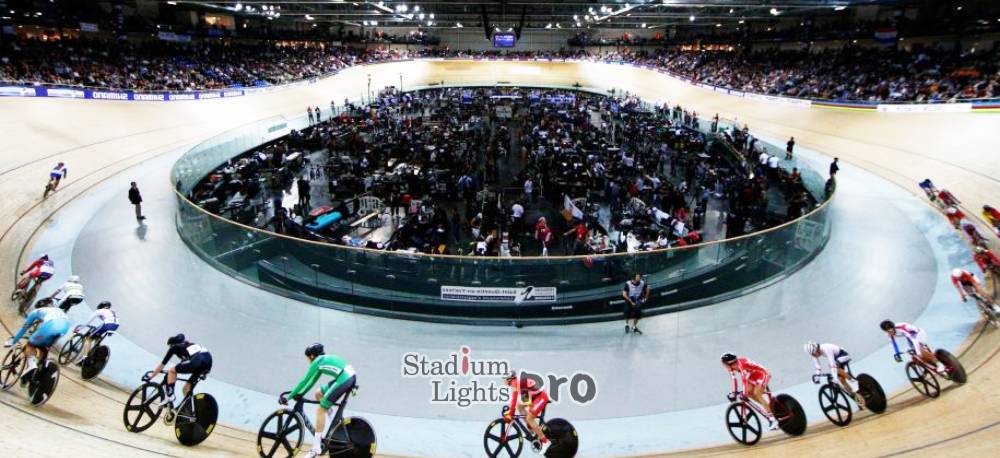
The purpose of lighting in a velodrome extends beyond brightness. It includes enhancing contrast, reducing glare, maintaining color accuracy, and minimizing shadows. Cyclists move at high speeds, and shadows or inconsistent lighting can lead to misjudgments or accidents. Spectators, whether present in person or watching a broadcast, also rely on quality lighting for a clear view of the action.
Lighting must be designed to eliminate hotspots while covering corners, straights, and curves evenly. Because of the continuous loop design of a velodrome, lighting must wrap the entire perimeter without gaps. This approach ensures the track looks consistent from every angle and supports camera coverage for television and media broadcasts.
Enhancing Visual Clarity for Athletes
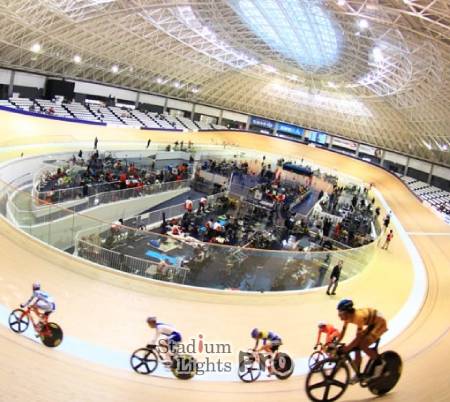 When cyclists are navigating banked curves at high speeds, their ability to detect subtle changes in track surface or positioning can directly affect performance and safety. Lighting that enhances visual clarity allows athletes to react more quickly to their environment. Clear definition of shadows, elevation, and curves makes a measurable difference in how riders perform, especially during sprints, exchanges, and mass-start races.
When cyclists are navigating banked curves at high speeds, their ability to detect subtle changes in track surface or positioning can directly affect performance and safety. Lighting that enhances visual clarity allows athletes to react more quickly to their environment. Clear definition of shadows, elevation, and curves makes a measurable difference in how riders perform, especially during sprints, exchanges, and mass-start races.
Even, diffused lighting helps maintain rider focus and situational awareness, reducing the chance of collisions or misjudged maneuvers. This is particularly relevant in velodromes hosting events under controlled indoor conditions where there is no natural light.
Reducing Glare for Safety and Comfort
Glare can be a dangerous distraction for athletes moving at high velocity. Poor fixture selection or improper aiming can result in concentrated brightness that obscures visibility. Glare is also uncomfortable for spectators and can diminish the overall experience of watching a race.
To reduce glare, lighting design should utilize fixtures with proper shielding and beam angles. Directional control is vital to illuminate surfaces without shining light directly into the eyes of riders or viewers. Fixtures should be mounted and angled with precision to avoid reflection off the smooth surfaces of the track.
Supporting Broadcast and Media Coverage
Velodromes are frequently used for professional events that are televised or live-streamed. Lighting quality directly impacts how cameras capture motion, color, and detail. Inadequate lighting can cause blurring, shadows, or color distortion on screen.
To support broadcasting, velodrome lighting must be flicker-free and maintain stable color temperature and intensity. Lighting systems should be designed with broadcast camera specifications in mind, particularly for high-speed recording and instant replay use. Multiple camera angles around the track benefit from consistent brightness and minimal shadowing, which allows producers to deliver professional-grade coverage without visual inconsistencies.
Minimizing Shadow Interference
Shadows can cause confusion during races, especially in high-density track events like Madison or points races. Moving shadows can distract riders or obscure another cyclist’s position. Shadows cast by track features such as barriers, seating, or even the cyclists themselves should be minimized through careful fixture placement.
Overhead and angled lighting from multiple sources helps to fill in areas where shadows would naturally form. This overlapping approach, combined with uniform spacing, keeps the track surface evenly illuminated at all times, regardless of movement or perspective.
Providing Visual Comfort for Spectators
Audience comfort is another component of lighting design. People attending events should be able to follow the action clearly without eye strain. Light spill into the seating areas should be minimal but sufficient to allow visibility for movement and interaction.
Carefully controlled lighting levels in the spectator zones ensure a comfortable experience without detracting from the focus on the track. Designing the lighting system to distinguish performance areas from audience zones enhances the visual hierarchy of the space and contributes to a more immersive event atmosphere.
Calculating the Number of Fixtures Required
| Factor | Details |
|---|---|
| Track Area | 38,000 to 45,000 square feet (including cycling loop, infield, spectator stands, and outer paths) |
| Target Lux Levels | 1000 lux for competitive events, 1200-1500 lux for broadcast, 600-800 lux for training facilities |
| Surface Area Calculation | 42,000 square feet = 3,902 square meters; To meet 1000 lux, need 3,902,000 lumens |
| Fixture Output | 55,000 lumens per LED sports floodlight; Approximately 71 fixtures needed for 3,902,000 lumens |
| Safety Factor | 1.3 safety factor to account for real-world losses, raising fixture requirement to approximately 94 |
| Beam Distribution | 30-degree beams for banked curves, 60-degree beams for straights, fixtures mounted 30-60 feet above the track |
| Material Reflectivity and Ceiling Height | Reflective surfaces reduce fixture needs by 15-20%; higher ceilings require more precise light control |
| Flexibility for Future Use | 5-10% extra fixtures for future upgrades (e.g., higher broadcast quality standards) |
| Maintenance and Adjustability | Lux audits every 12-18 months; smart systems for monitoring fixture performance and adjustments |
Determining how many lights are needed for a velodrome involves a layered assessment that accounts for overall dimensions, ceiling height, brightness expectations, and the capacity of selected fixtures. These calculations draw upon architectural plans, the material reflectance of surfaces, and the performance expectations of the space. Velodrome lighting designers start with precise blueprints and break the track into lighting zones for detailed planning.
In a standard 250-meter indoor velodrome, the track area typically spans between 38,000 and 45,000 square feet. This area includes the cycling loop, infield space, spectator stands, and outer circulation paths. Zones are created along the curved corners and straight lengths, each with tailored light angles and beam spreads. This zoning technique ensures light uniformity without over-saturating or neglecting key track segments.
Target Illumination Levels and Area Size
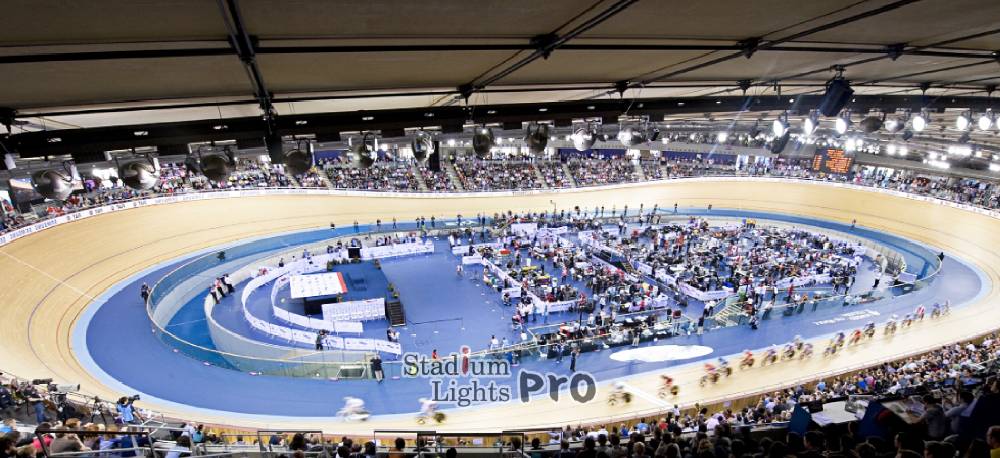
One of the most common lighting targets for competitive indoor velodromes is 1000 lux on the track surface. Broadcast-level lighting often raises this target to 1200 or even 1500 lux to meet HD television standards. Training facilities may operate with lower ranges around 600 to 800 lux. If a velodrome has a total surface area of 42,000 square feet and aims for a 1000 lux target, then the first step is converting square feet to square meters. Since one square foot equals approximately 0.092903 square meters, multiplying 42,000 by that factor gives about 3,902 square meters. To meet the lux requirement, the designer must then provide 3,902,000 lumens across the space, since lux is defined as lumens per square meter. This figure represents the minimum luminous output required across the entire velodrome to meet that lighting level.
Fixture Output and Distribution Strategy
Assuming the use of LED sports floodlights rated at 55,000 lumens per unit, designers would calculate the number of fixtures by dividing the required 3,902,000 lumens by the output per fixture. This results in approximately 71 fixtures. However, to account for real-world losses due to beam spill, reflection inefficiencies, and shadowing, a safety factor of 1.3 is typically applied. Multiplying 71 by 1.3 brings the requirement to just under 94 fixtures. This added buffer ensures more consistent lighting results under varying conditions. That brings the count to roughly 94 fixtures to maintain a reliable, consistent lighting level.
Example Beam Distribution and Mounting Layout
Lighting distribution is influenced not just by quantity, but by beam angles and mounting strategies. Banked curves often benefit from narrow 30-degree beams that concentrate light downward onto the angled surface, while the straight portions of the track are better served with medium-spread 60-degree beams that evenly distribute brightness across a wider area. When working with ceiling heights of around 45 feet, designers must calculate how far light will travel and compensate for the natural dispersion that occurs over distance. Fixtures with focused beams and higher intensity are preferred at these heights to ensure the light reaches the track with precision. A higher mounting point does not always mean better coverage without additional planning.
Rather than listing fixture counts per zone, a narrative layout would involve stating that a balanced arrangement often involves positioning a considerable portion of fixtures around the banked turns to compensate for their angled surface. The straights receive their share of the grid, supported by overhead mounting. Additional units may be positioned over the infield and perimeter walkways to ensure there are no dark areas and that the venue supports both performance and safety standards.
Using Photometric Simulation Software
Advanced lighting design integrates digital modeling into every step. Photometric simulation software such as DIALux and AGi32 enables designers to recreate the physical space virtually and insert real lighting models from manufacturers. The resulting simulation includes full lux maps, glare analysis, color temperature mapping, and three-dimensional light coverage visualizations. These digital mockups can test multiple lighting scenarios, beam angles, and wattages without physically altering a single fixture. Simulation saves both time and cost by validating designs before physical installation. Facility managers and stakeholders can view these models and make informed decisions on adjustments before final approval.
Commonly simulated beam angles include 15°, 30°, and 60°, each serving different roles in curved, straight, and overhead locations. The system even considers how shadows are cast by spectator seating, roof beams, and track features. Based on simulation outcomes, designers make micro-adjustments to tilt angles and fixture positions to remove dark spots or excessive glare, particularly around the most active parts of the velodrome like the corners and finishing stretch.
Reflectivity, Material Absorption, and Ceiling Height Impact
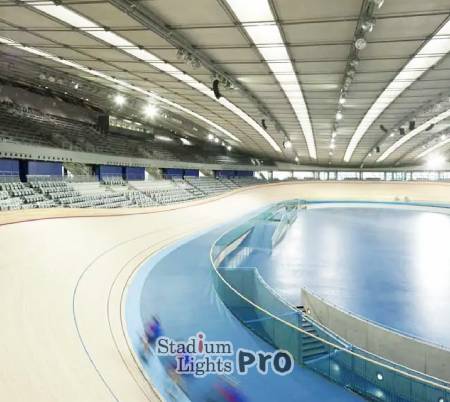 Surface finishes and colors within the velodrome directly impact how efficiently light is distributed. For example, polished timber surfaces used in professional cycling tracks reflect a greater portion of light compared to synthetic or rubberized alternatives. Walls painted with glossy, lighter colors help scatter light more effectively, while matte black or darker tones absorb more lumens, requiring a higher number of fixtures or more powerful outputs to achieve the same visual brightness.
Surface finishes and colors within the velodrome directly impact how efficiently light is distributed. For example, polished timber surfaces used in professional cycling tracks reflect a greater portion of light compared to synthetic or rubberized alternatives. Walls painted with glossy, lighter colors help scatter light more effectively, while matte black or darker tones absorb more lumens, requiring a higher number of fixtures or more powerful outputs to achieve the same visual brightness.
If two identical velodromes differ only in wall and ceiling finish—one using reflective light gray and the other matte charcoal—the darker venue may require 15 to 20 percent more fixtures to achieve the same lux level. Material absorption not only adds to energy consumption but also influences glare and contrast, affecting both rider visibility and spectator experience. Material reflectivity can swing fixture count by as much as 15–20%. Ceiling height further complicates planning. Higher ceilings demand longer throw distances and more precise beam control, increasing fixture wattage or narrowing beam spreads. Lower ceilings might allow for broader beam angles but reduce flexibility in aiming.
Balancing Precision and Future Adaptability
Lighting designs also accommodate future scenarios. It is not uncommon to design with a buffer—sometimes adding 5 to 10 percent more fixtures than needed to leave room for event-specific increases or upgrades in broadcast quality standards. This forward-looking approach ensures that lighting systems are not locked into a single configuration. Fixtures may feature adjustable tilt and beam shift mechanisms, allowing operators to rotate them without full reinstallation. Strategic flexibility in fixture planning makes lighting systems more durable across evolving usage needs.
Post-installation maintenance includes periodic lux audits, often conducted every 12 to 18 months. Using lift platforms, technicians can re-aim or clean fixtures to restore lost performance caused by dust, wear, or structural shifts. These small adjustments help maintain consistent light levels and color accuracy over the long term, preserving both safety and aesthetic value.
Mounting Options and Fixture Placement
How lighting fixtures are mounted in a velodrome dramatically shapes the quality of illumination throughout the facility. Mounting height, angle, and orientation all work together to deliver consistent brightness across the curved track and infield spaces. In indoor velodromes, fixtures are most often installed on ceiling-mounted structures or suspended from truss systems that run above the cycling track. These systems are designed to keep lights elevated and unobstructed while delivering focused coverage to both the banked turns and straightaways.
Ceiling Suspensions for Overhead Uniformity
Ceiling-mounted grids are the most common choice in modern velodrome lighting designs. High bay structures or custom truss assemblies are suspended anywhere from 30 to 60 feet above the track. These frameworks hold rows of fixtures at carefully calculated intervals. The positioning depends on the geometry of the building and the light distribution requirements of different track segments. Suspended lights provide overhead coverage that eliminates the need for intrusive floor or trackside units, which could interfere with cycling performance or spectator sightlines.
Lighting designers often simulate ceiling-mounted layouts in 3D modeling software to adjust for the velodrome’s curved architecture. They ensure beam angles overlap smoothly without creating hot spots or dead zones. These simulations allow them to test fixture locations with real-world product data, verifying that the selected arrangement delivers consistent lux levels throughout the venue.
Wall-Mounted Fixtures for Targeted Coverage
In specific areas of the track, particularly the corners or start/finish zones, wall-mounted fixtures provide supplemental lighting. These units are installed at intermediate heights on interior walls and angled downward at steep trajectories to concentrate light on specific zones. This approach is especially useful where ceiling height varies or when architectural constraints limit overhead rigging.
Wall-mounted fixtures serve as directional tools for shaping brightness on steeply banked curves, where vertical distance between ceiling and track may fluctuate more drastically. They also help enhance the depth and contrast needed for high-speed camera coverage or live broadcasting, particularly in sprint zones and during photo finishes. Their lower angle also reduces the risk of glare into rider sightlines when properly aimed.
Lighting Symmetry and Angling Techniques
Symmetry is central to delivering balanced lighting in an oval-shaped velodrome. Fixtures are often arranged in mirrored patterns along both the inner and outer perimeter of the track to ensure equal light levels across all lanes. This symmetry extends beyond simple fixture count—beam direction, tilt degree, and mounting height must also mirror one another to avoid uneven light gradients that could affect visibility and athlete perception of motion.
Adjustable brackets allow technicians to fine-tune the angling of each fixture. On the straight sections, medium-wide beam fixtures are often tilted to sweep light across the entire lane width, while narrower beams on the curves focus intensity downward where banking steepens. The angle of each fixture must also be coordinated with adjacent units to avoid crossing beams that may create harsh shadows or optical artifacts.
Start and Finish Line Highlighting
The start and finish lines demand a distinct lighting strategy. These areas not only carry athletic importance but also serve as visual focal points for spectators and television broadcasts. To emphasize these zones, designers incorporate higher-intensity floodlights mounted at oblique angles. These fixtures are typically installed at elevated positions either overhead or along adjacent walls, depending on structural access.
By angling the lights toward the track from multiple positions, designers achieve a layering effect that reduces shadows and enhances the clarity of motion. This setup supports slow-motion video capture, photo finishes, and clear live footage without requiring post-processing enhancements. These areas are also commonly equipped with redundant fixture support, so if one light fails, the overall brightness remains sufficient during critical race moments.
Access Considerations for Mounting and Maintenance
Mounting fixtures in high-ceiling environments introduces logistical challenges, both during installation and in future maintenance cycles. Designers work closely with structural engineers to ensure mounting points can handle fixture weight and vibration, especially when using adjustable beam heads. Access pathways must be incorporated into the design, such as catwalks or scissor lift routes, to allow regular servicing without disrupting daily operations or damaging the cycling surface below.
To simplify long-term maintenance, many velodromes choose modular mounting brackets and quick-release systems that allow technicians to replace or clean fixtures efficiently. In facilities with advanced lighting systems, remote diagnostic tools can assess each fixture’s output, thermal performance, and angle alignment. These smart systems alert staff if a fixture shifts, dims, or requires recalibration, reducing reliance on periodic full-scale lighting audits.
Impact of Mounting Choices on Fixture Efficiency
The mounting position influences how efficiently light energy is delivered to the track surface. A fixture placed too high without a focused beam can waste lumens into the upper ceiling void, reducing lighting efficiency. Conversely, a fixture mounted too low may create tight pools of brightness with harsh edge falloff, leading to patchy coverage. Designers aim for a sweet spot where the beam angle and mounting height combine to create even distribution with minimal wasted output.
Higher fixtures benefit from tighter beam angles and reflectors that control light spread, while mid-height wall units may use broader lenses to flood their target areas. The choice of lens type, shielding, and optical control system is tailored to the mounting method. By optimizing these elements, velodromes maximize the useful lumens delivered per watt consumed, helping control both energy costs and visual quality.
Factors Affecting the Number of Lights
Determining the number of lighting fixtures required for a velodrome is influenced by a variety of factors, each impacting how effectively the space can be illuminated. From the physical dimensions of the venue to the specific lighting goals for different track sections, understanding and evaluating these factors is essential to achieving uniform brightness and visibility. These considerations include the size of the space, lighting intensity goals, fixture efficiency, and the environmental conditions that can all affect how light behaves within the arena.
Track Size and Geometry
The dimensions and shape of the velodrome play a direct role in the number of fixtures needed. Larger venues, such as those with a 250-meter track, require more fixtures to cover the increased surface area. Additionally, the track’s oval shape introduces challenges related to even coverage of both straight and curved sections. The banked curves demand more strategic fixture placement, often requiring fixtures with narrow beams that can reach the higher elevations at the track’s corners. In contrast, the straights can benefit from fixtures with broader beam angles.
As the size of the venue increases, the lighting layout must also account for additional peripheral spaces such as infield areas, spectator seating, and walkways, which all contribute to the overall square footage that needs to be illuminated. The more expansive the area, the higher the fixture count required to meet uniform lighting targets across all sections of the facility.
Lighting Intensity Goals
The desired level of brightness, usually expressed in lux, is one of the most significant factors influencing the number of fixtures. Different events or types of training require different lux levels. For international competitions, lighting levels might need to exceed 1000 lux, with some high-definition broadcasts requiring upwards of 1500 lux to maintain visibility for cameras and athletes. On the other hand, recreational use or training may be sufficient with lower lux levels, reducing the number of lights required.
Achieving a specific lux target is not simply about the total area but how well the light is distributed across the space. Designers must calculate how many lumens are required to meet the desired lux value across the entire venue. The higher the target lux level, the more luminous output is needed, thus necessitating a greater number of fixtures to achieve even coverage at that intensity.
Fixture Output and Efficiency
The type and output of the lighting fixtures used in a velodrome significantly affect the number of lights required. LED fixtures, for example, are highly efficient and can produce a large amount of light with relatively low power consumption. However, the specific lumens each fixture can provide directly correlates with how many units are needed to meet the target lighting level. For instance, a fixture that produces 50,000 lumens may only require 50 fixtures to meet a particular lighting target, while a lower-output fixture may require 100 units to achieve the same result.
In addition to total lumens, fixture beam angles also affect light distribution. Narrow beam angles focus light on a small area, making them ideal for the steep banked curves, while wide beam angles are better suited for the flat straights. The efficiency of the fixture, including the quality of the optics used to direct the light, further influences how many fixtures are needed to achieve consistent and uniform lighting across all sections of the velodrome.
Ceiling Height and Mounting Position
Ceiling height plays an integral role in determining how many fixtures are required, as it affects the light’s ability to cover the track and infield area. Higher ceilings, which are common in many indoor velodromes, create more distance between the lights and the track, causing light to spread over a larger area and lose some of its intensity by the time it reaches the track surface. In such cases, fixtures with more powerful output or narrower beam angles are often necessary to maintain lighting intensity and uniformity.
Alternatively, in venues with lower ceilings, the fixtures can be placed closer to the track, reducing the amount of intensity loss over distance and potentially allowing for fewer fixtures. However, this also necessitates careful attention to the angle and direction of the light to avoid creating shadows or uneven lighting patterns. The overall layout of the lighting grid must compensate for these ceiling variations to ensure that light distribution remains uniform and efficient.
Surface Reflectivity and Material Types
The type of material used for the track surface and surrounding walls can have a significant impact on how light behaves in a velodrome. Reflective surfaces, such as polished wood or metal, bounce more light back into the environment, which can reduce the number of fixtures required to achieve the desired lighting levels. In contrast, darker surfaces, such as matte paints or rubberized coatings, absorb more light, meaning additional fixtures or higher-output units may be necessary to compensate for the light lost through absorption.
Surface reflectivity must be accounted for in lighting designs. A velodrome with a high-reflectance floor will require fewer fixtures to achieve a uniform lighting result compared to one with darker, more absorptive materials. Material choices in the walls and ceilings also affect light dispersion. Lighter-colored walls help reflect light across the venue, while darker materials may trap more light, requiring additional fixtures to maintain brightness levels.
Environmental Conditions and Temperature
Environmental factors, including the ambient temperature and humidity within the venue, also influence the lighting design. In high-humidity areas, fixtures may need additional protective features to prevent damage and maintain their efficiency over time. Temperature fluctuations can affect the output of certain lighting technologies, especially traditional bulbs, which are more sensitive to heat changes than LEDs. While LEDs are generally more temperature-resistant, their brightness and efficiency can still be affected by excessively high or low temperatures, requiring designers to factor in these environmental conditions when calculating fixture needs.
Moreover, the need for cooling mechanisms or heat dissipation strategies may arise, especially if a large number of high-intensity lights are used. These systems add another layer of complexity to the overall fixture count, as additional units may be required to compensate for lighting’s impact on the facility’s temperature regulation and air circulation.
Event Types and Usage Variability
Another factor that must be taken into account is the type of events the velodrome will host. High-profile events, such as international competitions or televised races, require higher lighting levels to ensure optimal visibility for athletes, spectators, and cameras. These events typically demand more lights or fixtures that can be adjusted to accommodate specific broadcast requirements, including avoiding shadows and ensuring that every section of the track is evenly illuminated under dynamic conditions.
Conversely, training sessions or off-peak periods may require lower lux levels and can therefore use fewer fixtures, or ones that are adjusted to accommodate less intensive lighting needs. Some velodromes may also be equipped with adjustable lighting systems that allow for flexibility, enabling operators to modify the lighting configuration depending on the event or activity being hosted. This flexibility in lighting setups is essential for ensuring that the venue is adaptable to varying usage scenarios.
Lighting Controls and Adjustability
The inclusion of lighting control systems in a velodrome can further impact the number of fixtures needed. Advanced control systems, such as dimming capabilities and adjustable beam patterns, allow for the fine-tuning of light levels based on specific needs, reducing the reliance on additional fixtures. These controls enable operators to adjust the lighting in real time to match event schedules, weather conditions, or the number of people in the facility.
Additionally, energy-efficient systems with built-in sensors that adjust lighting levels based on ambient light or occupancy can reduce the number of fixtures needed during non-peak hours, as the lights will only be active when necessary. By incorporating these technologies, velodromes can reduce both energy costs and fixture wear while maintaining optimal lighting conditions for all users.
Types of Lights Used in Velodromes
LED lighting has become the standard for modern velodromes. It offers advantages such as reduced power consumption, longer lifespan, and better beam control. LED fixtures can be tuned for specific beam angles and color temperatures, providing better flexibility for lighting designers.
In older velodromes, metal halide or high-pressure sodium lights might still be in use. These options are less efficient and have limitations in dimming and start-up times. LEDs can be switched on and off instantly and can even integrate with smart controls to adapt to changing needs. LEDs also generate less heat, which is especially useful for indoor environments.
Final Thoughts on Lighting a Velodrome
Lighting a velodrome is a complex balance of performance, safety, and visual quality. The number of lights required depends on many factors including track dimensions, lux targets, and the chosen lighting technology. Indoor and outdoor venues have different demands, and the level of competition or broadcast requirement further influences fixture count. LED lighting continues to lead the industry for its efficiency, beam control, and longevity.
Uniformity, color accuracy, and smart control features elevate a lighting system from basic to high-performance. Proper planning and simulation using industry tools are vital for achieving optimal results. While there is no one-size-fits-all answer, the approach to calculating how many lights are needed must consider not just the numbers but how the lighting contributes to the entire velodrome experience.
